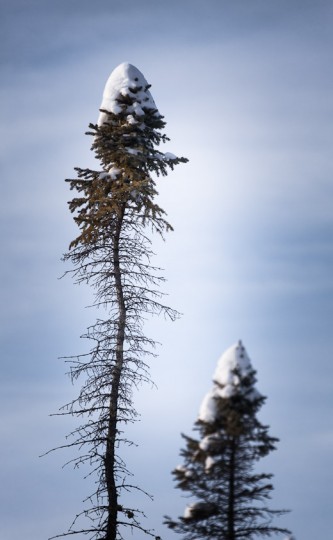 Snow cap on thin black spruce After receiving huge amounts of new snow over the past few weeks, we finally got a day where the sun managed to peak—weakly—through the clouds for a few hours. Since I was already on the west side of town, I decided to head out to the Wagner Natural Area where, I hoped, the dense spruce trees covered in deep snow would provide an interesting photographic opportunity or two.
It was more challenging than I expected—the huge amount of snow often looked like just a big pile slumped over everything, rather than contrasting or complimenting the forms of the trees. But a challenge can be good fun, and I did get a couple images that I’m quite happy with—I’ll share some more over the next little while.
 Non-vignetted The processing in this one was inspired by an image by a local photographer who I’ve mentioned before, Joel Koop. He posted an image on his blog that was heavily vignetted (darkened in the corners) in post-processing—and it looked great. I had already processed this one with a little bit of vignetting, but his image inspired me to try pushing it a bit further, and I think I like it this way. What do you think? (I’ve included the non-vignetted version here for comparison—use your arrow keys to switch between versions.)
 Bright morning light on Whirlpool Mountain Here’s another photograph from my first photo-trip of the year in Jasper National Park. I made this image from along the Icefields Parkway, about 20 minutes south of the town of Jasper. I’m not sure about the name of this peak, but my best guess is that it’s Whirlpool Mountain, just south of Mount Edith Cavell and north of Mount Geraldine (if anybody can confirm/correct this, please leave me a comment).
The deep blue of the sky is due mostly to the use of a polarizing filter which really brought out the contrast between the sky, the shadows on the mountain, and the bright snow-covered faces.
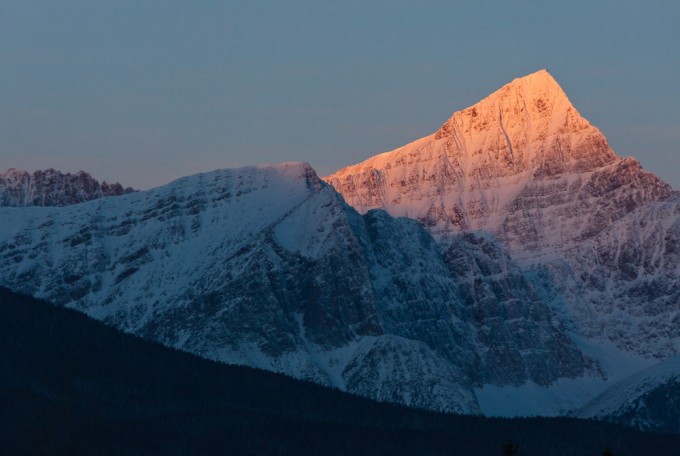 First light on south face of Mount Edith Cavell Happy New Year! After a great trip to the west coast for the holidays, I had the pleasure of spending my first photography trip of the new year in the heart of the Rocky Mountains—Jasper National Park. I could hardly have asked for a better way to start the year than to be out there watching the sun come up over freshly snow-blanketed peaks, and freezing my fingers on my camera. I have a bunch of new photos that I’m excited to share, so check back soon!
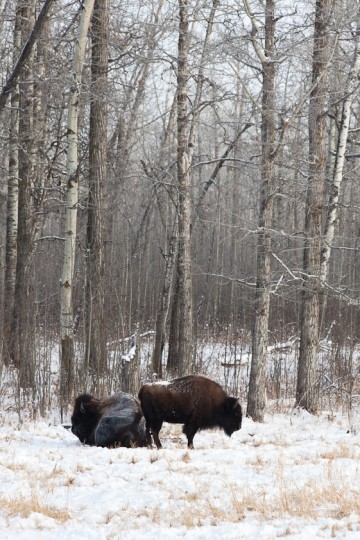 Resting winter bison It’s been a wintry couple of days in the Edmonton area, but these bison don’t seem to mind it. I took this photograph out at Elk Island Park recently, and I love how the fresh snow is just lying on top of the large bison. I had the good fortune of being able to watch a small herd slowly moving along and grazing through the snow for about an hour before they moved further off into the trees.
I made a lot of images of the herd, but I was surprised when I got home and could look at the photos large on my computer, how many times there were stray pieces of grass in front their faces—not necessarily ruining the shot, but definitely distracting. I guess it makes sense—the bison spent almost the entire time grazing with their heads just above the ground, and the dried grass was often over half a meter high. It’s just interesting how, while I was there, my brain could ignore the visual distractions, but at home, the light yellow-brown slashes against the deep, dark brown really stood out. Something to watch for next time…
P.S. I hope you like the “new and improved” larger in-post images starting with this entry. As always, you can click an image to view it full-screen. Enjoy!
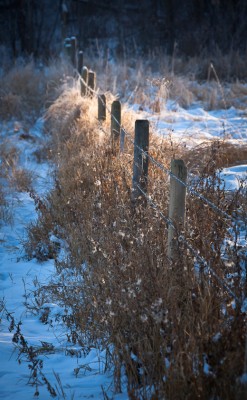 Dried winter grasses along barbed wire fence The “Golden Hour” is generally thought of as the first and last hour of sunlight in the day. During this time, the low angle of the sun casts soft, warm sidelighting that gives beautiful definition to a subject while keeping the contrast low and enhancing the rich colours. But during the winter, here at our northern latitudes, that light can last for most of the day.
It’s not uncommon for landscape photographers to pack it in after first light, however another Edmonton photographer whose work I really enjoy, Joel Koop, recently wrote a pair of blog posts (here and here) sharing how he takes on the challenge of mid-day light. I couldn’t agree more with him, and especially at this time of year I love to be outside in the afternoon, looking for just the right patch of light. (I took the photograph above in late November at just before 3 in the afternoon.)
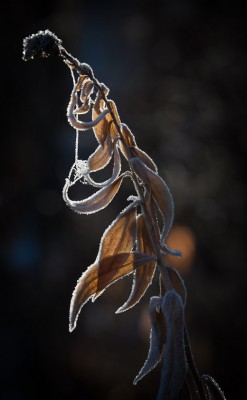 Dried Goldenrod leaves with hoar frost Although this photograph was from a little earlier in the season than my last post, it was a similarly frosty, beautiful day. It’s amazing how a lining of frost can add definition and visual interest to an otherwise subdued scene. This is especially true when photographing with the sun behind your subject, the backlighting making the frost shine while the rest of the subject remains shadowed. I also added a fairly heavy vignetting effect while processing this image, to further draw attention to the lines created by the curled, dried goldenrod leaves.
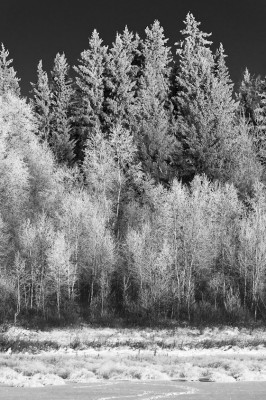 Frost covered trees on bright winter day It’s been too long since I last posted a new photograph—my apologies. Here is an image I made recently, on a particularly gorgeous afternoon at the Ministik Lake Game Bird Sanctuary just east of Edmonton. All of the trees, shrubs, and even each blade of grass was bearing a thick covering of frost. The sky was perfectly clear and everything was sparkling—it was beautiful (and cold).
When I was processing this photograph, I used the digital equivalent of the technique of placing a red filter in front of the lens to darken the blue sky. This technique (a favourite of Ansel Adams) adds a dramatic look to the sky and making the brightness of the foreground trees stand out even more.
|
(Click photos to enlarge)
|









